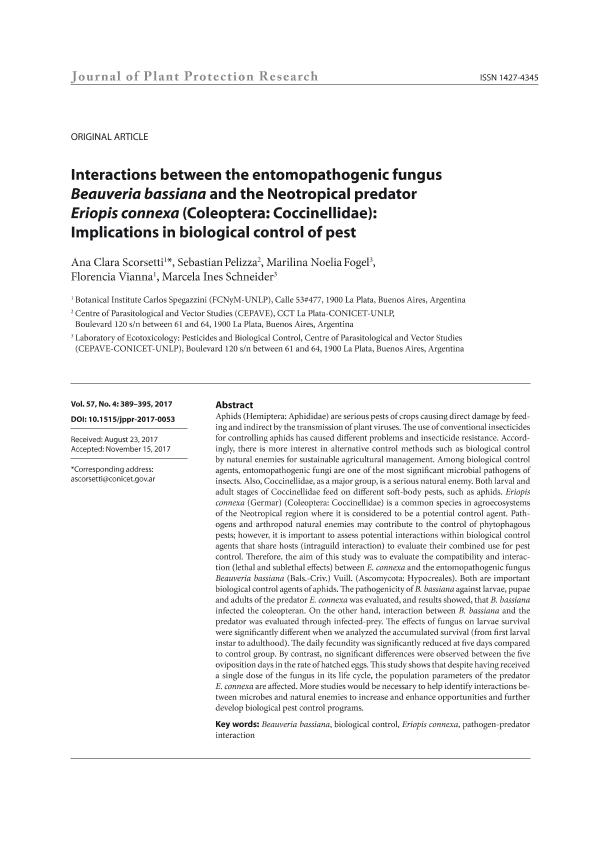Mostrar el registro sencillo del ítem
dc.contributor.author
Scorsetti, Ana Clara

dc.contributor.author
Pelizza, Sebastian Alberto

dc.contributor.author
Fogel, Marilina Noelia

dc.contributor.author
Vianna, María Florencia

dc.contributor.author
Schneider, Marcela Inés

dc.date.available
2018-10-22T20:20:52Z
dc.date.issued
2017-11
dc.identifier.citation
Scorsetti, Ana Clara; Pelizza, Sebastian Alberto; Fogel, Marilina Noelia; Vianna, María Florencia; Schneider, Marcela Inés; Interactions between the entomopathogenic fungus Beauveria bassiana and the Neotropical predator Eriopis connexa (Coleoptera: Coccinellidae): Implications in biological control of pest; Polish Academy of Sciences; Journal of Plant Protection Research; 57; 4; 11-2017; 389-395
dc.identifier.issn
1427-4345
dc.identifier.uri
http://hdl.handle.net/11336/62880
dc.description.abstract
Aphids (Hemiptera: Aphididae) are serious pests of crops causing direct damage by feeding and indirect by the transmission of plant viruses. The use of conventional insecticides for controlling aphids has caused different problems and insecticide resistance. Accordingly, there is more interest in alternative control methods such as biological control by natural enemies for sustainable agricultural management. Among biological control agents, entomopathogenic fungi are one of the most significant microbial pathogens of insects. Also, Coccinellidae, as a major group, is a serious natural enemy. Both larval and adult stages of Coccinellidae feed on different soft-body pests, such as aphids. Eriopis connexa (Germar) (Coleoptera: Coccinellidae) is a common species in agroecosystems of the Neotropical region where it is considered to be a potential control agent. Pathogens and arthropod natural enemies may contribute to the control of phytophagous pests; however, it is important to assess potential interactions within biological control agents that share hosts (intraguild interaction) to evaluate their combined use for pest control. Therefore, the aim of this study was to evaluate the compatibility and interaction (lethal and sublethal effects) between E. connexa and the entomopathogenic fungus Beauveria bassiana (Bals.-Criv.) Vuill. (Ascomycota: Hypocreales). Both are important biological control agents of aphids. The pathogenicity of B. bassiana against larvae, pupae and adults of the predator E. connexa was evaluated, and results showed, that B. bassiana infected the coleopteran. On the other hand, interaction between B. bassiana and the predator was evaluated through infected-prey. The effects of fungus on larvae survival were significantly different when we analyzed the accumulated survival (from first larval instar to adulthood). The daily fecundity was significantly reduced at five days compared to control group. By contrast, no significant differences were observed between the five oviposition days in the rate of hatched eggs. This study shows that despite having received a single dose of the fungus in its life cycle, the population parameters of the predator E. connexa are affected. More studies would be necessary to help identify interactions between microbes and natural enemies to increase and enhance opportunities and further develop biological pest control programs.
dc.format
application/pdf
dc.language.iso
eng
dc.publisher
Polish Academy of Sciences
dc.rights
info:eu-repo/semantics/openAccess
dc.rights.uri
https://creativecommons.org/licenses/by-nc-sa/2.5/ar/
dc.subject
Beauveria Bassiana
dc.subject
Biological Control
dc.subject
Eriopis Connexa
dc.subject
Pathogen-Predator Interaction
dc.subject.classification
Otras Ciencias Biológicas

dc.subject.classification
Ciencias Biológicas

dc.subject.classification
CIENCIAS NATURALES Y EXACTAS

dc.title
Interactions between the entomopathogenic fungus Beauveria bassiana and the Neotropical predator Eriopis connexa (Coleoptera: Coccinellidae): Implications in biological control of pest
dc.type
info:eu-repo/semantics/article
dc.type
info:ar-repo/semantics/artículo
dc.type
info:eu-repo/semantics/publishedVersion
dc.date.updated
2018-06-22T15:06:23Z
dc.journal.volume
57
dc.journal.number
4
dc.journal.pagination
389-395
dc.journal.pais
Polonia

dc.journal.ciudad
Poznari
dc.description.fil
Fil: Scorsetti, Ana Clara. Universidad Nacional de la Plata. Facultad de Ciencias Naturales y Museo. Instituto de Botánica Spegazzini; Argentina. Consejo Nacional de Investigaciones Científicas y Técnicas; Argentina
dc.description.fil
Fil: Pelizza, Sebastian Alberto. Consejo Nacional de Investigaciones Científicas y Técnicas. Centro Científico Tecnológico Conicet - La Plata. Centro de Estudios Parasitológicos y de Vectores. Universidad Nacional de La Plata. Facultad de Ciencias Naturales y Museo. Centro de Estudios Parasitológicos y de Vectores; Argentina
dc.description.fil
Fil: Fogel, Marilina Noelia. Consejo Nacional de Investigaciones Científicas y Técnicas. Centro Científico Tecnológico Conicet - La Plata. Centro de Estudios Parasitológicos y de Vectores. Universidad Nacional de La Plata. Facultad de Ciencias Naturales y Museo. Centro de Estudios Parasitológicos y de Vectores; Argentina
dc.description.fil
Fil: Vianna, María Florencia. Universidad Nacional de la Plata. Facultad de Ciencias Naturales y Museo. Instituto de Botánica Spegazzini; Argentina. Consejo Nacional de Investigaciones Científicas y Técnicas; Argentina
dc.description.fil
Fil: Schneider, Marcela Inés. Consejo Nacional de Investigaciones Científicas y Técnicas. Centro Científico Tecnológico Conicet - La Plata. Centro de Estudios Parasitológicos y de Vectores. Universidad Nacional de La Plata. Facultad de Ciencias Naturales y Museo. Centro de Estudios Parasitológicos y de Vectores; Argentina
dc.journal.title
Journal of Plant Protection Research
dc.relation.alternativeid
info:eu-repo/semantics/altIdentifier/url/https://content.sciendo.com/view/journals/jppr/ahead-of-print/article-10.1515-jppr-2017-0053.xml
dc.relation.alternativeid
info:eu-repo/semantics/altIdentifier/doi/http://dx.doi.org/10.1515/jppr-2017-0053
Archivos asociados
